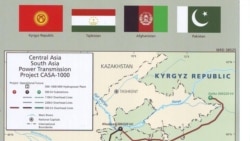The United States is pleased to commit $15 million in financing towards the Central Asia-South Asia electricity transmission project (CASA-1000). The U.S. believes CASA-1000 can be a potentially transformative project, helping create a regional energy grid that connects Central and South Asia for the first time. The U.S. hopes U.S. financial support for CASA-1000 will encourage other donors to support the project and enable the World Bank to present the project to its Board of Directors for final approval of World Bank funding later this year.
When completed, CASA-1000 will allow Tajikistan and Kyrgyzstan to profit from existing, unused summer generation capacity by selling electricity to Afghanistan and Pakistan. Afghanistan would doubly benefit from the project as a consumer (300 MW) and as a transit country generating revenue. Pakistan would add 1000 MW to its national grid during the summer months when it experiences its peak demand period and have access to a reliable, clean, and cheaper energy supply.
CASA-1000 is entirely dependent on existing hydropower generation so it will not affect water-sharing agreements for other Central Asian countries. It also complements ongoing efforts by the Asian Development Bank and others to support a regional energy grid. These types of projects can enhance economic interdependence and support peace and stability in the region for years to come. That is why the United States has been supporting the CASA-1000 Secretariat for several years, and is now committing an equity stake in the project.
U.S. support for CASA-1000 underscores our long-term commitment to peace, stability and prosperity for Afghanistan and its neighbors. CASA-1000 is a practical example of a project that supports regional economic connectivity and our New Silk Road vision. The United States looks forward to working with the World Bank, the Islamic Development Bank, and other development partners to support CASA-1000 and other projects which connect Central and South Asia.
When completed, CASA-1000 will allow Tajikistan and Kyrgyzstan to profit from existing, unused summer generation capacity by selling electricity to Afghanistan and Pakistan. Afghanistan would doubly benefit from the project as a consumer (300 MW) and as a transit country generating revenue. Pakistan would add 1000 MW to its national grid during the summer months when it experiences its peak demand period and have access to a reliable, clean, and cheaper energy supply.
CASA-1000 is entirely dependent on existing hydropower generation so it will not affect water-sharing agreements for other Central Asian countries. It also complements ongoing efforts by the Asian Development Bank and others to support a regional energy grid. These types of projects can enhance economic interdependence and support peace and stability in the region for years to come. That is why the United States has been supporting the CASA-1000 Secretariat for several years, and is now committing an equity stake in the project.
U.S. support for CASA-1000 underscores our long-term commitment to peace, stability and prosperity for Afghanistan and its neighbors. CASA-1000 is a practical example of a project that supports regional economic connectivity and our New Silk Road vision. The United States looks forward to working with the World Bank, the Islamic Development Bank, and other development partners to support CASA-1000 and other projects which connect Central and South Asia.
















